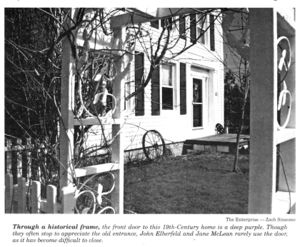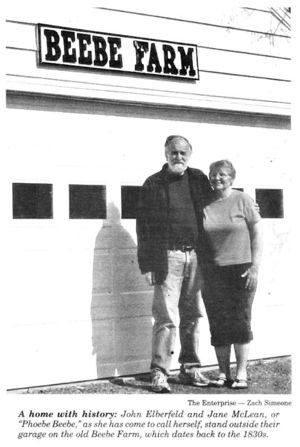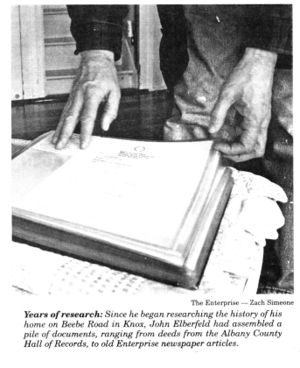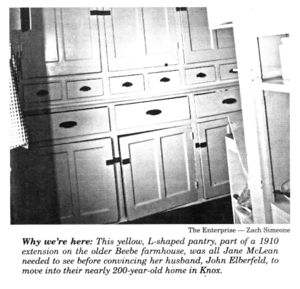Kiwanis Club of the Helderbergs Member Researches Old House - John Elberfeld




(John Elberfeld has been a member of the Kiwanis Club of the Helderbergs since 2002. Jane McLean is active in many Kiwanis activities as well. Both John and Jane are active in the Helderberg Hilltowns Association.)
Knox couple research the history of their home and share the knowledge
By Zach Simeone
KNOX— Some people research family trees, tracing their roots back generations to find out where they came from. But when John Elberfeld and Jane McLean moved to Knox in 2002, the couple instead sought a historical perspective on the house they fell in love with.
Elberfeld, a 66-year-old retired teacher, hails from Westborough, Mass.; McLean, a 62-year-old speech pathologist, grew up in Antrim, N.H. The two met in 1963 in McLean's home state, and spent some years moving around before landing in the Hilltowns in 2002.
"We're both from New England, so we're kind of country bumpkins," McLean said. "John has always done research and other genealogy, so he knew some of the good resources."
He began investigating the old house in 2004, and his quest for context continued until last year.
He started at the Albany County Hall of Records.
"They were very good to me, and showed me that once you get one deed, they always refer back to the previous deed," Elberfeld ex¬plained. "So, by being very patient and getting a lot of help, I traced it back to an 1836 deed."
The home was originally owned by Charlie Beebe, a well-known name in the area, McLean said. To find out more, the couple joined the Knox Historical Society.
"Everybody would say, 'Oh, Charlie Beebe, you've got to talk to so and so,"' McLean said. Networking led to more knowledge. Elberfeld dug up yet more at the Berne Historical Society.
"Each room has a theme and information, and then they have a backroom that is just full of pictures and books and information," said Elberfeld. The Gristmill in Rensselaerville also yielded findings.
"The people down there worked very hard to index a lot of the records they have," he said. They also have file cabinets from an Albany genealogist, Charlotte T. Luckhurst. "After she died, they were going to junk her stuff, but they got ahold of it," he said.
The couple also searched for obituaries on Beebe and other previous owners.
"One thing I found interesting is, this is less than an acre of land that we own, but Charlie Beebe had 120 acres," Elberfeld said. "People bought all his land except this tiny plot and turned it into a subdivision...So all these houses you see around here are part of that subdivision."
The full story varies depending on whom you ask, but Elberfeld shared one rumor that he had heard.
"Charlie was a good Christian man, and one of the stories is, someone promised him they were putting in a Christian boys' school," Elberfeld said. "So, he was willing to part with the land... Instead of this huge agricultural area, they turned this whole area into a subdivision."
Added McLean, "We're in the Helderberg Hilltowns Association, trying to find ways to support local farmers so the next place up doesn't turn into another subdivision."
Elberfeld also used http://www.AlbanyHilltowns.com as a resource; this website has been the project of Harold Miller, a former Hilltown resident who began organizing the Helderberg Hilltowns Association from his home in Mexico in an effort to strategize ways of boosting the local economy.
Home, sweet home
"There's always the question," Elberfeld went on, "there's a deed from a house from 1836, but was it this exact house? Or was another built in its place?"
But several small details led the couple to believe that this was, indeed, the home in which Charlie Beebe resided when the original Beebe Farm was still flourishing.
"The house is of the right age," McLean began. "It's the architecture of the front; it's a Greek Revival farmhouse. If you drive around and start looking, you'll see many Greek Revivals. This is a very common architecture, and that's the time it was built: the 1800s."
Elberfeld added, "Down in the cellar, they have these huge beams, and you can still see where they used their axes on these to hold the place up; hand-hewn beams."
The house had no central heating, and the couple currently uses a corn-burning furnace for warmth. The house had no running water until about 20 years ago.
Though the couple touched up the home a great deal after they moved in, the age still shows where the walls and ceiling meet.
"If you look at this wall, you can see things sort of curve around; there are no right angles really anywhere," said Elberfeld. Above the doorframe between the living room and the kitchen, the ceiling sinks down close to four inches below where the corners of the room meet; the doorway almost appears to be smiling as it welcomes you into the kitchen.
"The kitchen was an addition," said McLean, "and that was a very common thing to do, to add a summer kitchen at a later time when they outgrew the original house."
They estimate that this addition took place around 1910, and it was this slightly newer area to which McLean grew instantly attached. "The reason we bought the house is the pantry," said McLean. "The house had been on the market for a long time. It was kind of nasty, and people didn't want to buy it."
But when she saw the cozy, L-shaped pantry at the far end of the kitchen, lined with floor-to-ceiling cupboards and complete with its own window, she begged her husband to agree to purchase the house.
The angled, bright yellow space makes visitors feel as though they've stepped into a massive banana — one with room to store many actual bananas. When the couple was choosing a color, it was January, and the cold and gray weather was dampening McLean's spirits, so she went with an uplifting color.
"If we were painting it now, I may have done things differently," she laughed. But, her passion for the pantry aside, it's the original house that contains the majority of this home's Hilltown heritage.
"There's an amazing amount of information in these towns," con¬cluded McLean — or as she now calls herself, "Phoebe Beebe."
"It had to rhyme," she said, "like my real name."
Those interested in seeing how John Elberfeld went about his research can attend his presenta¬tion for the Guilderland Historical Society tonight, Thursday, April 28, 2011 at the Mynderse-Frederick House, located at 451 Route 146, at 7:30 p.m.
- Altamont Enterprise - April 28, 2011